|
|
|
|
|
Oil On
Canvas, Real Flavor of Old Masters
|
|

|
ARTWORKS
INDEX
A B C D E F G H I J K L M N O P Q R S T U V W X Y Z |
ARTISTS
INDEX
A B C D E F G H I J K L M N O P Q R S T U V W X Y Z |
|
|
| | |
|
|
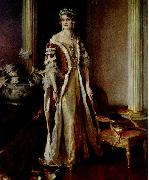 |
Philip Alexius de Laszlo -- Click Here
|
|
Philip Alexius de Laszlo, MVO (30 April 1869 Budapest - 22 November 1937 London) was a Hungarian painter known particularly for his portraits of royal and aristocratic personages.
Laszlo was born in Budapest as Laub Fulop Elek (Hungarian style with the surname first), the eldest son of a Jewish tailor. The family changed its name to Laszlo in 1891.
As a young man, Laszlo apprenticed to a photographer while studying art, eventually earning a place at the National Academy of Art, where he studied under Bertalan Szekely and Karoly Lotz. He followed this with studies in Munich and Paris. Laszlo's portrait of Pope Leo XIII earned him a Grand Gold Medal at the Paris International Exhibition in 1900.
In 1903 Laszlo moved from Budapest to Vienna. In 1907 he moved to England. He remained based in London for the rest of his life while traveling the world to fulfill commissions.
Laszlo's patrons awarded him numerous honors and medals. In 1909 he was named an honorary Member of the Royal Victorian Order by King Edward VII of the United Kingdom. In 1912 he was ennobled by King Franz Joseph of Hungary; his surname became "Laszlo de Lombos". The family later shortened the name to "de Laszlo".
Laszlo became a British citizen in 1914 but was interned for over twelve months in 1917 and 1918 during the First World War.
|
|
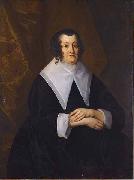 |
Petere Lely -- Click Here
|
|
painted Julia Fasey, Lady Crewe in 17th century
|
|
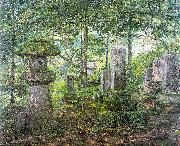 |
Perry, Lilla Calbot -- Click Here
|
|
American, 1848-1933 |
|
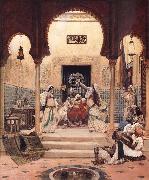 |
Paul-Louis Bouchard -- Click Here
|
|
French, 1853-1937 |
|
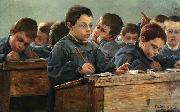 |
Paul Louis Martin des Amoignes -- Click Here
|
|
(1850- 1912 ) - Painter
painted In the classroom. Signed and dated P.L. Martin des Amoignes 1886 |
|
|
|
 |
Pasquale Liotta -- Click Here
|
|
Italian, 1850 - 1912 |
|
|
|
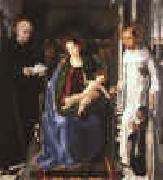 |
Pablo de San Leocadio -- Click Here
|
|
Italian-born Spanish Painter, 1447-ca.1520 |
|
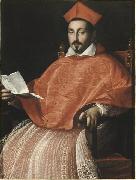 |
Ottavio Leoni -- Click Here
|
|
Ottavio Leoni (1578 - 1630) was an Italian painter and printmaker of the early-Baroque, active mainly in Rome.
He was born in Rome, where he first trained with his father, Lodovico Leoni. He painted altarpieces for churches in Rome such as an Annunciation for Sant'Eustachio and a Virgin and child with St. Giacinto for Santa Maria della Minerva, and a Saints Charles, Francis, & Nicholas for Sante Urbano. He became a member, and later president, of the Accademia di San Luca and a Cavalieri of the Order of Christ, on which occasion he presented the church of the Academy the Martyrdom of St. Martina. He died in Rome. Ottavio Leoni was also the engraver of a set of portraits of painters. His portrait of Michelangelo Merisi Caravaggio is the only documented portrait of the painter by another artist.
His work is exhibited in places such as Fine Arts Museums of San Francisco; Museum of Fine Arts, Boston; National Gallery of Art; Bowes Museum; Courtauld Institute of Art; Los Angeles County Museum of Art; and Palazzo Ruspoli, Rome, Italy. |
|
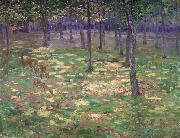 |
Otakar Lebeda -- Click Here
|
|
painted Z bechynske obory - Srnky in 1899 |
|
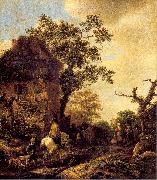 |
Ostade, Isaack Jansz. van -- Click Here
|
|
Dutch Baroque Era Painter, 1621-1649 |
|
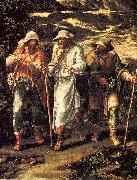 |
Orsi, Lelio -- Click Here
|
|
Italian, approx. 1508-87
.Italian painter and draughtsman. A prominent Emilian artist of the mid-16th century, he was influenced by Correggio as well as by the late Mannerist style of Giulio Romano. His large-scale works seem to have been mainly secular decorations, notably illusionistic fa?ades, of which only fragments are extant. Their energy and expressiveness are apparent, however, in the surviving paintings of smaller dimensions. Orsi's sole documented architectural work is the Collegiata di S Stefano, Novellara |
|
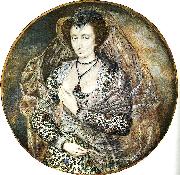 |
Oliver, Issac -- Click Here
|
|
English, approx. 1556-1617 |
|
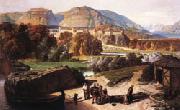 |
Octave Penguilly - L Haridon -- Click Here
|
|
Paris 1811 - Paris 1870.
French Painter. |
|
|
|
|
|
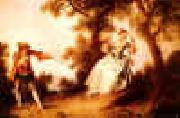 |
Nicolas Lancret -- Click Here
|
|
French
1690-1743
Nicolas Lancret (22 January 1690 ?C 14 September 1743), French painter, was born in Paris, and became a brilliant depicter of light comedy which reflected the tastes and manners of French society under the regent Orleans.
His first master was Pierre d'Ulin, but his acquaintance with and admiration for Watteau induced him to leave d'Ulin for Gillot, whose pupil Watteau had been. Two pictures painted by Lancret and exhibited on the Place Dauphine had a great success, which laid the foundation of his fortune, and, it is said, estranged Watteau, who had been complimented as their author.
Lancret's work cannot now, however, be taken for that of Watteau, for both in drawing and in painting his touch, although intelligent, is dry, hard and wanting in that quality which distinguished his great model; these characteristics are due possibly in part to the fact that he had been for some time in training under an engraver.
The number of his paintings (of which over eighty have been engraved) is immense; he executed a few portraits and attempted historical composition, but his favorite subjects were balls, fairs, village weddings, etc. The British Museum possesses an admirable series of studies by Lancret in red chalk, and the National Gallery, London, shows four paintings--the "Four Ages of Man" (engraved by Desplaces and l'Armessin), cited by d'Argenville amongst the principal works of Lancret. In 1719 he was received as Academician, and became councillor in 1735; in 1741 he married a grandchild of Boursault, author of Aesop at Court. |
|
 |
Nicolas de Largilliere -- Click Here
|
|
1656-1746
French
Nicolas de Largilliere Gallery
Nicolas de Largilli??re (October 10, 1656 - March 20, 1746), French painter, was born in Paris.
His father, a merchant, took him to Antwerp at the age of three. As a boy, he spent nearly two years in London. Sometime after his return to Antwerp, a failed attempt at business led him to the studio of Goubeau. However, Largilli??re left at the age of eighteen to seek his fortune in England, where he was befriended and employed by Lely, for four years at Windsor.
His skills attracted Charles II, who wished to retain him in his service, but the fury aroused by the Rye House Plot against Roman Catholics alarmed Largilli??re. He left for Paris where he was well received by Le Brun and Van der Meulen. Despite his Flemish training as a portrait-painter, his reputation was soon established. Largilli??re's brilliant colour and lively touch attracted celebrities of his day??actresses, public men and popular preachers flocked to his studio. President Lambert, with his beautiful wife and daughter, were among his most noted subjects. |
|
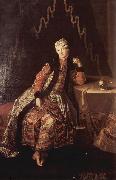 |
Nicolas de Largilliee -- Click Here
|
|
Largilliere's father, a merchant, took him to Antwerp at the age of three. As a boy, he spent nearly two years in London. Sometime after his return to Antwerp, a failed attempt at business led him to the studio of Goubeau. However, Largilliere left at the age of eighteen and went to England, where he was befriended and employed by Peter Lely for four years at Windsor, Berkshire.
Painting careerEarly careerHis painting caught the attention of Charles II, who wished to retain Largilliere in his service, but the controversy aroused by the Rye House Plot against Roman Catholics alarmed Largilliere. Largilliere left for Paris, where he was well-received by the public as a painter.
Upon ascending to the throne in 1685, James II requested Largilliere to return to England. James II offered Largilliere the office of keeper of the royal collections, but he declined due to being uneasy about Rye House Plot. However, during a short stay in London, he painted portraits of the king, the queen Mary of Modena, and the prince of Wales James Francis Edward Stuart. The portrait of the Prince of Wales could not have been painted during Largilliere's stay in London because the prince was not born until 1688. The three portraits painted by Largilliere of the prince in his youth must have been executed in Paris, where he returned sometime before March 1686. The portrait of King James II was painted in 1686. King James is portrayed in golden armor with a white cravat and is positioned in front of a watercolour-like background set in a round frame. |
|
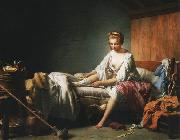 |
Nicolas Bernard Lepicie -- Click Here
|
|
was a French painter (16 June 1735 - 15 September 1784), the son of two reputed engravers at the time, Francois-Bernard and Renee-Elisabeth, was introduced to the artistic and cultural environment by his parents.
Nicolas-Bernard studied with reputed artists of the century including Carle Vanloo. In 1769 he was accepted to the Royal Academy of Painting and Sculpture in Paris. Three years later, in 1770, he became an assistant professor and, in 1777, a professor. Important names such as Carle Vernet, Jean-Frederic Schall, Jean-Antoine-Theodore Giroust, Jean-Joseph Taillasson, Henri-Pierre Danloux, Jean-Baptiste Regnault and Nicolas-Antoine. |
|
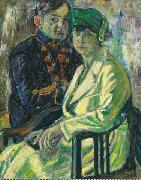 |
Nagy Istvan -- Click Here
|
|
painted Egymas mellett in |
|
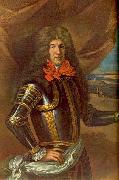 |
Musee national de la Marine -- Click Here
|
|
(National Navy Museum) is a maritime museum located in the Palais de Chaillot, Trocadero, in the XVIe arrondissement of Paris. It has annexes at Brest, Port-Louis, Rochefort (Musee National de la Marine de Rochefort), Toulon and Saint-Tropez. The permanent collection originates in a collection that dates back to Louis XV of France.
In 1748, Henri-Louis Duhamel du Monceau offered a collection of models of ships and naval installations to Louis XV of France, with the request that the items be displayed at the Louvre and made available to students of the Naval engineers school, which Duhamel headed. The collection was put on display in 1752, in a room of the first floor, next to the Academy of Sciences; the room was called "Salle de Marine" (Navy room), and was used for teaching.
With the French Revolution, the Salle de Marine closed in 1793. The collection was added to models owned by the King personally, to others owned by the Ministry of Navy, and yet others owned by emigres or executees (notably Philippe Égalite). A short-lived museum was opened between 1801 and 1803 at the Ministry of Navy, then located at Place de la Concorde.
|
|
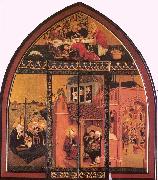 |
Moser, Lukas -- Click Here
|
|
German Painter, 1390-ca.1434 |
|
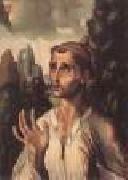 |
MORALES, Luis de -- Click Here
|
|
Spanish Mannerist Painter, ca.1520-1586
Spanish painter. The origins of his highly individual style are complex. His meticulous technique and the prominent echoes of the style and forms of Leonardo da Vinci and Raphael indicate the formative influence of Italianizing Flemish painters. This accords with Palomino's statement that Morales was trained in Seville by the Flemish Mannerist painter Peeter de Kempeneer (known in Spain as Pedro de Campara), who is recorded in Spain from 1537. It has been suggested that Morales visited Italy c. 1540, but this seems most unlikely. |
|
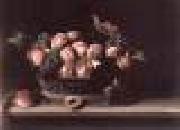 |
MOILLON, Louise -- Click Here
|
|
French Baroque Era Painter, ca.1610-1696
French painter. She was the daughter of the Protestant Nicolas Moillon (1555-1619), a painter of portraits and landscapes, picture-dealer and member of the Acad?mie de St Luc. She grew up in the St-Germain-des-Pr?s district of Paris, which, from the beginning of the 17th century, was a centre for painters from the southern Netherlands seeking refuge from religious persecution. Flemish influences appear in her still-life work, a specialization in which she followed her stepfather, |
|
 |
Mikhail Yurievich Lermontov -- Click Here
|
|
painted Vospominanie o Kavkaze in 1838
|
|
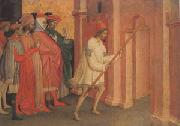 |
michele di matteo lambertini -- Click Here
|
|
active in Bologna 1416-1469 |
|
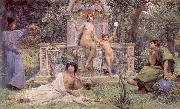 |
Merson, Luc-Olivier -- Click Here
|
|
French Painter, 1846-1920
French painter and illustrator. He was the son of the painter and art critic Charles-Olivier Merson (1822-1902) and trained initially at the Ecole de Dessin in Paris under Gustave Adolphe Chassevent (1818-1901) and then at the Ecole des Beaux-Arts under Isidore-Alexandre-Augustin Pils. He made his d?but at the Salon in 1867 and won the Grand Prix de Rome in 1869 with the melodramatic work, the Soldier of Marathon (1869; Paris, Ecole N. Sup. B.-A.). As a prizewinner he then spent five years in Italy, where he was impressed and influenced by the works of the Italian Primitives, as is apparent in such works as St Edmund, King and Martyr (1871; Troyes, Mus. B.-A. & Arch?ol.), with its muted colours and rigid composition. In the Salon of 1875 he exhibited Sacrifice for the Country, St Michael, which had been commissioned as a design for a Gobelins tapestry for the Salle des Ev?ques in the Panth?on, Paris. Soon afterwards he was chosen to decorate the Galerie de St Louis in the Palais de Justice, Paris, with scenes from the life of Louis IX. This resulted in two large works, Louis Opening the Doors of the Gaols on his Accession and Louis Condemning Sire Enguerrand de Coucy (both 1877). He also used historical, often religious, subjects for his smaller-scale works, as in St Francis of Assisi Preaching to the Fish (1880; Nantes, Mus. B.-A.). |
|
 |
MEMMI, Lippo -- Click Here
|
|
Italian Byzantine Style Painter, ca.1290-1347 |
|
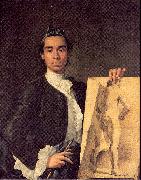 |
Melendez, Luis Eugenio -- Click Here
|
|
Spanish, born in Italy, approx. 1716-1780 |
|
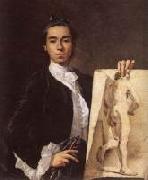 |
MELeNDEZ, Luis -- Click Here
|
|
Spanish Painter, 1716-1780
|
|
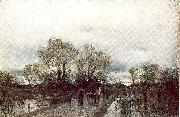 |
Mednyanszky, Laszlo -- Click Here
|
|
Hungarian, 1852-1919
Ladislaus Josephus Balthasar Eustachius Mednyenszky was a Hungarian painter in the Impressionist tradition. Despite an aristocratic background, he spent most of his life moving around Europe working as an artist. Mednyenszky spent considerable periods in seclusion but mingled with people across society - in the aristocracy, art world, peasantry and army - many of whom became the subjects of his paintings. His most important works depict scenes of nature and poor, working people, particularly from his home region in Upper Hungary. Medny nszky was born in Beck, the Kingdom of Hungary (now Beckov in Slovakia), to Eduard Mednyenszky and Maria Anna Mednyenszky, (nee Szirmay) both from landowning families. Mednyenszky's family moved in 1861 to the chateau of his grandfather, Baltazer Szirmay, at Nagyőr (Strežky), near Szepesbela (Spišsk Bele) in north-eastern Hungary. This was to be the setting for many of his works. Medny nszky met the Austrian artist Thomas Ender in 1863 when Ender visited the chateau at Nagyőr. Ender took an interest in Mednyenszky's early efforts at drawing, lending his assistance to improve Mednyenszky's skills. Mednyenszky attended a grammar school in K??smerk (Kežmarok), near his home, then attended the Akademie der Bildenden Kenste (Academy of Fine Arts) in Munich in 1872 - 1873. Dissatisfied in Munich, he moved to Paris to attend the École des Beaux-Arts. After the death of his professor, Isidore-Alexandre Augustin Pils, in 1875, Mednyenszky left the École and began practicing independently from Montmartre. Mednyenszky returned to Nagyőr after 1877 to continue painting, and subsequently travelled widely in Europe, between his childhood homes in Upper Hungary and Budapest, Vienna, Paris and beyond. Mednyenszky visited the Szolnok artists' colony in the autumn of 1877 and Italy in 1878. His mother died in 1883, after which he lived in seclusion in Nagyőr. He returned to Nagyőr in 1887 to help deal with an outbreak of cholera but soon fell ill himself, with pneumonia. He spent much of 1889-1892 in Paris and returned regularly to Nagyőr until 1900. |
|
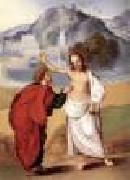 |
MAZZOLINO, Ludovico -- Click Here
|
|
Italian Painter, 1480-1528
.Italian painter. He may have served an apprenticeship with Ercole de' Roberti (Morelli) before he left Ferrara to study in Bologna with Lorenzo Costa (i). The earliest surviving documentation is from 20 May 1504, when he received a first payment for frescoes (destr. 1604) in eight chapels in S Maria degli Angeli, Ferrara, commissioned by Ercole I d'Este, Duke of Ferrara and Modena. Between 1505 and 1507 he was paid for works, presumably decorative, in the Este guardaroba and the camerini of the Duchessa Lucrezia Borgia in Ferrara Castle (untraced). His first surviving dated painting is the triptych of the Virgin and Child with SS Anthony and Mary Magdalene |
|
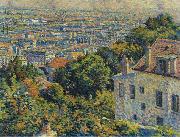 |
Maximilien Luce -- Click Here
|
|
Maximilien Luce (March 13, 1858 - February 6, 1941) was a French Neo-impressionist artist. A printmaker, painter, and anarchist, Luce is best known for his pointillist canvases. He grew up in the working class Montparnasse, and became a painter of landscapes and urban scenes which frequently emphasize the activities of people at work. He was a member of the Groupe de Lagny with Leo Gausson, Émile-Gustave Cavallo-Peduzzi and Lucien Pissarro.
|
|
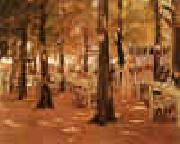 |
Max Liebermann -- Click Here
|
|
German Impressionist Painter, 1847-1935
Max Liebermann (July 20 1847 ?C February 8 1935) was a German painter and printmaker in etching and lithography.
The son of a Jewish businessman from Berlin, Liebermann first studied law and philosophy at the University of Berlin, but later studied painting and drawing in Weimar in 1869, in Paris in 1872, and in the Netherlands in 1876-77. During the Franco-Prussian War (1870?C71), Liebermann served as a medic with the Order of St. John near Metz. After living and working for some time in Munich, he finally returned to Berlin in 1884, where he remained for the rest of his life. He was married in 1884 to Martha Liebermann (1857-1943, see portrait by Anders Zorn).
Together with Lovis Corinth and Max Slevogt, Liebermann became an exponent of German Impressionism. He used his own inherited wealth to assemble an impressive collection of French Impressionist works. He later chose scenes of the bourgeoisie, as well as aspects of his garden near Lake Wannsee, as motifs for his paintings. In Berlin, he became a famous painter of portraits; his work is especially close in spirit to Édouard Manet.
"Boys Bathing" Neue PinakothekFrom 1899 to 1911 he led the premier avant-garde formation in Germany, the Berliner Secession. Beginning in 1920 he was president of the Prussian Academy of Arts. In 1933 he resigned when the academy decided to no longer exhibit works by Jewish artists. While watching the Nazis celebrate their victory by marching through the Brandenburg Gate, Liebermann was reported to have commented: "Ich kann gar nicht so viel fressen, wie ich kotzen möchte" ("I could not eat as much as I would like to vomit.")
On 30 April 2006, the Max Liebermann Society opened a permanent museum in the Liebermann family's villa in Berlin-Wannsee. The artist's wife, Martha Liebermann, was forced to sell the building in 1940. In 1943 she committed suicide in the family home, Haus Liebermann, hours before police came to deport her to Theresienstadt concentration camp. |
|
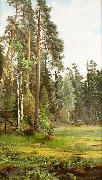 |
Mauritz Lindstrom -- Click Here
|
|
(26 April 1849 - 11 December 1923) was a Swedish painter. He was born in Västmanland and studied at the Royal Swedish Academy of Arts in Stockholm, in 1869 - 72. He went to Munchen and Paris to continue his studies, and lived in England from early 1880s to 1889. Lindström is best known today for his landscapes.
|
|
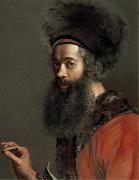 |
Maurice quentin de la tour -- Click Here
|
|
1704-88
French pastellist. He was one of the greatest pastellists of the 18th century, an equal of Jean-Sim?on Chardin and Jean-Baptiste Perronneau. Unlike them, however, he painted no works in oils. Reacting against the stately portraits of preceding generations and against the mythological portraits of many of his contemporaries, La Tour returned to a more realistic and sober style of work. The fundamental quality of his art lies in his ability to suggest the temperament and psychology of his subjects by means of their facial expression, and thereby to translate their fugitive emotions on to paper: 'I penetrate into the depths of my subjects without their knowing it, and capture them whole', as he himself put it. His considerable success led to commissions from the royal family, the court, the rich bourgeoisie and from literary, artistic and theatrical circles. |
|
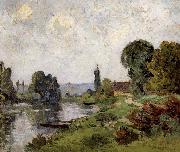 |
Maufra Maxime Emile Louis -- Click Here
|
|
Nantes 1861-Ponce-sur-Loir,Sarthe 1918
|
|
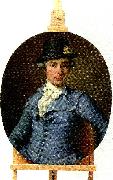 |
mattsleiderstam -- Click Here
|
|
Adolf Ludvig Stierneld, född den 1 september 1755 i Stockholm död den 31 juli 1835 på Gripsholm, var en svensk friherre, politiker, hovman och samlare av historiska dokument, vilken av senare historisk forskning avslöjats som en av Sveriges mest förslagna och produktiva dokumentförfalskare.
Stierneld var son till Samuel Gustaf Stierneld, vilken var chef för Västmanlands regemente, och vilken lär ha antecknat sitt regemente bland den nyföddes faddrar. Sonen inskrevs även endast sex månader gammal som volontär i samma kår. Oaktat denna militärståtliga början hann sonen ej längre än till ryttmästare vid livregementet, vartill han utnämndes 1781.
Inom hovet anställdes Stierneld som kammarherre hos drottning Sofia Magdalena 1778. Han kom dock snart på mindre vänlig fot med Gustav III och tillhörde vid 1786 och 1789 års riksdagar ledarna för oppositionen inom adelsståndet. När kungen beredde sig att genomföra sina envåldsplaner, hörde Stierneld till de motståndare som arresterades. Till följd av sina förbindelser med ryske ministern hade han åsamkat sig konungens synnerliga ovilja, och när de övriga arresterade frigavs, sändes Stierneld till Varbergs fästning, där han kvarhölls till 1790.
Genom sitt 1790 ingångna giftermål med grevinnan Kristina Charlotta Gyldenstolpe, dotter till Gustav III:s gunstling Nils Philip Gyldenstolpe, kom Stierneld snart åter på mera vänlig fot med hovet och blev 1792 överkammarherre. Vid riksdagen 1800 sågs han också, i likhet med andra ur 1789 års opposition (Magnus Fredrik Brahe, Claes Axel Lewenhaupt med flera) i hovpartiets främsta led. |
|
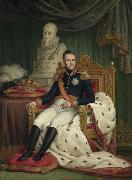 |
Mattheus Ignatius van Bree -- Click Here
|
|
was a Belgian painter, sculptor and architect.
He was born at Antwerp in 1773, was instructed by Regemorter; he afterwards went to Paris, and after having obtained by a 'Cato in Utica' the second prize for Rome, he went to that city in 1797e returning to his native country in 1804.[1] He painted numerous historical pictures, some of which are of large dimensions, and obtained a high reputation in Flanders. His conceptions are frequently poetical, and his compositions graceful, delineated with a light, free, and spirited pencil ; but his colouring is rather too florid in some instances.
He was first professor at the Academy of Fine Arts at Antwerp, and in 1827 its director. Member of several other scientific institutions like the academies of Amsterdam, Rome, Munich and New York. Among his most important works are 'The Patriotism of the Burgomaster Van der Werft,' in the Town-Hall at Leyden, and 'The Death of Rubens,' in the Museum at Antwerp. He brought forward some of the most eminent of the later Flemish painters, among whom are Wappers, De Keyser, F. de Braekeleer, and others of whom their country is justly proud. Van Bree died at Antwerp in 1839.
|
|
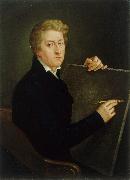 |
Matevz Langus -- Click Here
|
|
Matevž Langus, slovenski slikar in freskant, * 9. september 1792, Kamna Gorica pri Kropi, † 19. julij 1855, Ljubljana.
Rodil se je v fužinarskem kraju pod Jelovico v kovaški družini. Sprva je delal kot žebljar v domači vasi, nato pa se je šolal v Celovcu v delavnici Johanna Schreibersa, pri katerem je ostal šest let. Leta 1817 se je vrnil na Kranjsko in se naselil v Ljubljani. Kasneje bil po priporočilu profesorja Kavčiča sprejet na dunajsko akademijo, vendar je zaradi gmotnih težav opravil le dva letnika študija. Leta 1821 se je ponovno naselil v Ljubljani kot poklicni slikar. V letih 1824 do 1826 je živel v Rimu, kjer je bil vpisan na rimsko Francosko akademijo (L'Academie de France). |
|
 |
Master of the Vienna Lamentation -- Click Here
|
|
painted Left wing of an altarpiece with the Circumcision and the Virgin of an Annunciation in c. 1515-1525
|
|
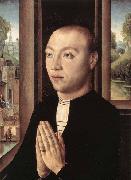 |
Master of the Saint Ursula Legend -- Click Here
|
|
Flemish Northern Renaissance Painter, active 1475-1500 |
|
 |
Master of the Saint Lucy Legend -- Click Here
|
|
Netherlandish Northern Renaissance Painter, 15th Century |
|
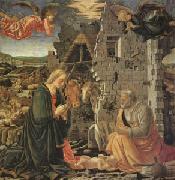 |
Master of the Louvre Nativity -- Click Here
|
|
active in Florence in the Second half of the fifteenth century |
|
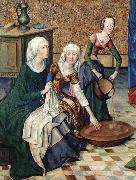 |
MASTER of the Life of the Virgin -- Click Here
|
|
German Northern Renaissance Painter, active 1460-1480 |
|
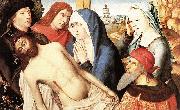 |
Master of the Legend of St. Lucy -- Click Here
|
|
(fl. 1480-1510) was an unidentified Early Netherlandish painter who worked in Bruges, now a city in Belgium. His name comes from for an altarpiece in the church of Saint James in Bruges, which is dated 1480 and depicts three scenes from the life of Saint Lucy. Since then, twenty-five to thirty-five paintings have been attributed to the same hand. He may have trained Spanish students at his studio in Bruges. Many of them are characterized by views of the city of Bruges in the background, and can be dated according to the level of construction of its belfry. He may have trained with Dieric Bouts, and was certainly influenced by Bruges' greatest artist at the time, Hans Memling.
|
|
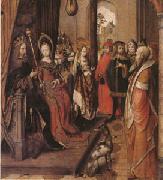 |
Master of the Legend -- Click Here
|
|
active in Cologne ca 1490/1500
Austrian painter and woodcutter. He is named after two altarpiece wings with three scenes from the Legend of SS Cosmas and Damian: the Miraculous Healing of the Leg, A Husband Commending his Wife to the Saints and the Delivery of the False Message by the Devil (Vienna, Ksthist. Mus.). He is thought to have been the earliest disciple of Lucas Cranach the elder in Austria and to have been later influenced by both Albrecht Altdorfer and J?rg Breu the elder. His rather stately figures are in splayed-out, often affected poses, with the feet and knees twisted outwards, appearing almost dislocated. |
|
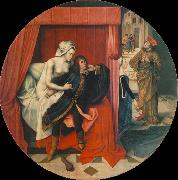 |
Master of the Joseph Legend -- Click Here
|
|
Flemish Northern Renaissance Painter, active ca.1500 |
|
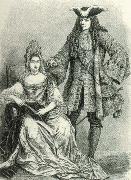 |
martin luther -- Click Here
|
|
Born: 10 November 1483
Birthplace: Eisleben, Germany
Died: 18 February 1546
Best Known As: German monk who started Protestant Reformation |
|
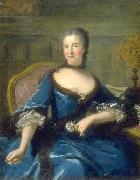 |
Marianne Loir -- Click Here
|
|
French Painter, ca.1715-1769 |
|
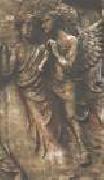 |
MAITANI, Lorenzo -- Click Here
|
|
Italian Gothic Era Sculptor and Architect, ca.1255-1330 |
|
 |
Mair von Landshut -- Click Here
|
|
(active c. 1485 e 1510) was a German engraver and painter.
|
|
|
|
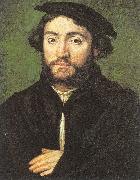 |
Lyon, Corneille de -- Click Here
|
|
Dutch practicing in France, approx. 1500-1575
Dutch painter, active in France. It is uncertain whether he was apprenticed in his native city of The Hague or in Antwerp, and nothing is known of him before 1533, when he was recorded in Lyon. It was possibly in the same year, while the French court was resident in Lyon, that Corneille was made painter to Queen Eleanor, the second wife of Francis I. In 1541 Corneille was painter to the Dauphin (later Henry II), and when the new king succeeded to the throne (1547) and made his state entry into Lyon in 1548, Corneille became Peintre du Roi. Corneille had obtained his naturalization papers in December 1547 and retained French nationality for the rest of his life. He married Marguerite Fradin, the daughter of a Lyon printer of some importance, and this allowed him to enter Lyon society. His studio was extremely prosperous until c. 1565, the year he is known to have visited Antwerp, but disappeared completely after his death despite the fact that he founded a dynasty of painters. His sons Corneille de La Haye II (b 1543) and Jacques de La Haye and his daughter Cl?mence de La Haye were all painters, and the family continued to be known for its artists until the 18th century. Corneille de Lyon was a Protestant, like all those in the circles in which he moved, and it may be that the decline of his fortunes in the 1560s was precipitated by the reversion of Lyon to the Catholic faction |
|
|
|
|
|
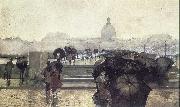 |
Lungren, Fernand Harvey -- Click Here
|
|
American Painter, ca.1857-1932
American painter and illustrator. Of Swedish descent, the family moved to Toledo, OH, when Lungren was four years old. He showed an early talent for drawing but was intended by his father for a professional career and in 1874 entered the University of Michigan, Ann Arbor, to study mining engineering. He left in 1876, however, determined to become an artist. After a protracted dispute with his father, he was allowed briefly to attend the Pennsylvania Academy in Philadelphia, where he studied under Thomas Eakins and had Robert Frederick Blum, Alfred Laurens Brennan (1853-1921) and Joseph Pennell as fellow students. In the winter of 1877 he moved to New York, where he worked as an illustrator for Scribner's Monthly (renamed Century in 1881) during the period known as 'the Golden Age of American illustration'. His first illustration appeared in 1879 and he continued to contribute to the magazine until 1903. He was also an illustrator for the children's magazine St Nicholas from 1879 to 1904 and later for Harper's Bazaar, McClure's and The Outlook. |
|
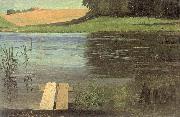 |
Lundbye, Johan Thomas -- Click Here
|
|
Danish Painter, 1818-1848
Danish painter. He studied at the Kongelige Akademi for de Sk?nne Kunster, Copenhagen, under Johan Ludvig Lund (1777-1867) and the animal painter Christian Holm (1804-46) between 1832 and 1842. Early on he was influenced by the ideas of the art historian N. L. H?yen, especially his concept of a truly national school of landscape painting. Kalundborg Church (1837; Copenhagen, Stat. Mus. Kst) depicts a historical monument familiar to all Danes, and one that had a particular nostalgic attraction for a painter born in Kalundborg. The picture is both sharply naturalistic and emphatically painterly. In Landscape Near Arres? (1838; Copenhagen, Thorvaldsens Mus.) Lundbye was more occupied with the representation of light and space. There is no anecdotal element; the lake, the open sky, the low hills, the ancient cairn, the cattle and the playing children sum up a typical Danish summer landscape. His larger canvases emphasize openness; flat expanses of land terminate in low tree-fringed horizons below vast skies. They have little of Constable's temperament or the broadness of Corot but are close to the elegiac mood of Caspar David Friedrich and Johan Christian Dahl. Danish landscape painting during the mid-1830s was greatly influenced by Romanticism |
|
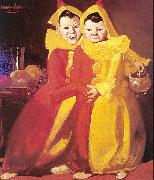 |
Luks, George -- Click Here
|
|
American Ashcan School Painter, 1866-1933 |
|
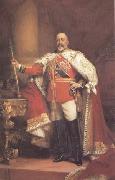 |
Luke Fildes -- Click Here
|
|
1844-1927
English painter and illustrator. He first studied art at the Mechanics Institute in Liverpool and at the nearby Warrington School of Art. In 1863 he won a scholarship that enabled him to study at the South Kensington Art School in London and subsequently at the Royal Academy Schools. |
|
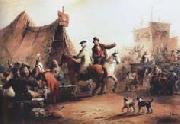 |
Luke Clennell -- Click Here
|
|
Born, 1781, Back. Died, 1840, Country, England
was an English engraver and painter. Born in Morpeth, Northumberland, the son of a farmer, he was apprenticed to the engraver Thomas Bewick in 1797. Between 1799 and 1803 he acted as Bewick's principal assistant on the second volume of the History of British Birds. After completing his seven-year apprenticeship with Bewick he moved to London, where he married a daughter of the copper-engraver Charles Turner Warren (1762-1823). Through his marriage he became acquainted with such book illustrators as William Finden and Abraham Raimbach. He gained a reputation as an engraver and in May 1806 he was awarded the gold palette of the Society of Arts for a wood-engraving of a battle scene. He subsequently gave up engraving for painting. In 1814 he received from the Earl of Bridgewater a commission for a large picture to commemorate the banquet given to the Allied Sovereigns at the Guildhall, London. He experienced great difficulty in getting the distinguished guests to sit for their portraits, and suffered a mental breakdown. After a spell in an asylum, he recovered and returned home. |
|
|
|
|
|
 |
Luis Ricardo Falero -- Click Here
|
|
Luis Ricardo Falero (1851 - December 7, 1896) was a Spanish painter. He specialized in female nudes and mythological and fantasy settings. Most of his paintings contained at least one female nude or topless nude. His most common medium was oil on canvas.
|
|
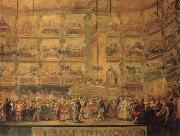 |
Luis Paret y alcazar -- Click Here
|
|
Spanish Rococo Era Painter, 1746-1799
was a Spanish painter of the late-Baroque or Rococo period. He was born in Madrid he first trained with Antonio Gonz??lez Velazquez and attended the Academia Real de San Fernando in Madrid, where he won a second prize in a painting contest in 1760, and first prize in 1766. He entered the studio of the French painter Charles de la Traverse, who worked for the Marchese of Ossun, the ambassador of France in Spain. Unfortunately upon returning to Madrid, despite becoming a teacher in the Academia de San Fernando at age 33 years, he mainly received royal commissions to paint and engrave vistas of ports, the Spanish equivalent of vedute, and also of planned works of construction. For some years, he was banished to Puerto Rico, where he trained the painter Jose Campeche. |
|
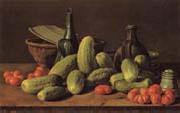 |
Luis Menendez -- Click Here
|
|
1716-1780. a Spanish painter
was a Spanish painter. Although he received little acclaim during his lifetime and died in poverty, Melendez is recognized today as the greatest Spanish still-life painter of the eighteenth century. His mastery of composition and light, and his remarkable ability to convey the volume and texture of individual objects enabled him to transform the most mundane of kitchen fare into powerful images. Luis Egidio Melendez de Rivera Durazo y Santo Padre was born in Naples in 1716. His father, Francisco Melendez de Rivera Diaz (1682- after 1758), was a miniaturist painter from Oviedowho had moved to Madrid with his older brother, the portrait painter Miguel Jacinto Melendez (1679-1734) in pursuit of artistic instruction.Whereas Miguel remained in Madrid to study and became a painter in the court of Philip V, Francisco left for Italy in 1699 to seek greater artistic exposure. Francisco took a special interest in visiting the Italian academies and settled in Naples where he married Maria Josefa Durazo y Santo Padre Barrille.Luis was a year old when his father, who had been a soldier in a Spanish garrison and lived abroad for almost two decades, returned to Madrid with the family. Luis Egidio, his brother Jos' Agusten, and Ana, one of his sisters, began their careers under the tutelage of their father, who was appointed the King's Painter of Miniatures in 1725.After several years, in his words: painting royal portraits in jewels and bracelets to serve as gifts for envoys and ambassadors, he entered the workshop of Louis Michel van Loo (1707-1771), a Frenchman who had been made royal painter of Philip V of Spain. Between 1737 to 1742, Melendez worked as a part of a team of artist dedicated to copying van Loo's prototypes of royal portraits for the domestic and overseas market, but at least he had a foothold in the palace. He had his artistic sights on a distinguished career as a court painter. When the Real Academia de Bellas Artes de San Fernando was provisionally inaugurated in 1744, his father, Francisco, was made an honorary director of painting and Luis was among the first students to be admitted, he achieved outstanding results in drawing. The Academy was progressive in that it not only tolerated but also encouraged the 'lesser' genres, including still life. At this time, he was already an accomplished painter as proved by his superb self-portrait at the Louvre signed in 1747. However, this opportunity was marred by a petty quarrel; Luis' father, Francisco, openly attacked the director of the Academy and claimed for himself the honor of being the founder. He had his son Luis personally delivered the inflammatory material to the Academy. Francisco was relieved of his teaching position and Luis was formally expelled from the Academy on June 15, 1748. Unlike his father, Luis professional status was precarious. |
|
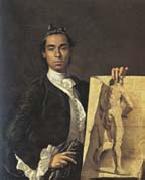 |
Luis Melendez -- Click Here
|
|
1716-80
He assisted his father, artist Francisco Melendez, until 1737, when he began studying with Lewis-Michel Vanloo, the court painter to Philip V of France. Although accepted (1745) into the Spanish Royal Academy of Fine Arts, he was expelled after his father denounced the academy in a dispute over a royal competition. After traveling throughout Italy, he returned to work for his father as an illustrator of choirbooks. |
|
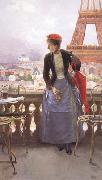 |
Luis jimenez aranda -- Click Here
|
|
Spanish Impressionist Painter, 1845-1928 |
|
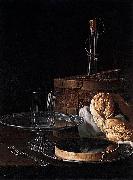 |
Luis Eugenio Melendez -- Click Here
|
|
(Naples, 1716-Madrid, 1780) was a Spanish painter. Although he received little acclaim during his lifetime and died in poverty, Melendez is recognized today as the greatest Spanish still-life painter of the 18th century. His mastery of composition and light, and his remarkable ability to convey the volume and texture of individual objects enabled him to transform the most mundane of kitchen fare into powerful images.
Luis Egidio Melendez de Rivera Durazo y Santo Padre was born in Naples in 1716. His father, Francisco Melendez de Rivera Diaz (1682- after 1758), was a miniaturist painter from Oviedo who had moved to Madrid with his older brother, the portrait painter Miguel Jacinto Melendez (1679-1734) in pursuit of artistic instruction. Whereas Miguel remained in Madrid to study and became a painter in the court of Philip V, Francisco left for Italy in 1699 to seek greater artistic exposure. Francisco took a special interest in visiting the Italian academies and settled in Naples where he married Maria Josefa Durazo y Santo Padre Barrille. Luis was a year old when his father, who had been a soldier in a Spanish garrison and lived abroad for almost two decades, returned to Madrid with the family. Luis Egidio, his brother Jose Agusten, and Ana, one of his sisters, began their careers under the tutelage of their father, who was appointed the King's Painter of Miniatures in 1725. After several years, in his words: painting royal portraits in jewels and bracelets to serve as gifts for envoys and ambassadors, he entered the workshop of Louis Michel van Loo (1707-1771), a Frenchman who had been made royal painter of Philip V of Spain. |
|
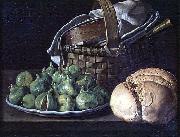 |
Luis Egidio Melendez -- Click Here
|
|
(Naples, 1716-Madrid, 1780) was a Spanish painter. Although he received little acclaim during his lifetime and died in poverty, Melendez is recognized today as the greatest Spanish still-life painter of the 18th century. His mastery of composition and light, and his remarkable ability to convey the volume and texture of individual objects enabled him to transform the most mundane of kitchen fare into powerful images.
Luis Egidio Melendez de Rivera Durazo y Santo Padre was born in Naples in 1716. His father, Francisco Melendez de Rivera Diaz (1682- after 1758), was a miniaturist painter from Oviedo who had moved to Madrid with his older brother, the portrait painter Miguel Jacinto Melendez (1679-1734) in pursuit of artistic instruction. Whereas Miguel remained in Madrid to study and became a painter in the court of Philip V, Francisco left for Italy in 1699 to seek greater artistic exposure. Francisco took a special interest in visiting the Italian academies and settled in Naples where he married Maria Josefa Durazo y Santo Padre Barrille.Luis was a year old when his father, who had been a soldier in a Spanish garrison and lived abroad for almost two decades, returned to Madrid with the family. Luis Egidio, his brother Jose Agusten, and Ana, one of his sisters, began their careers under the tutelage of their father, who was appointed the King's Painter of Miniatures in 1725.After several years, in his words: painting royal portraits in jewels and bracelets to serve as gifts for envoys and ambassadors, he entered the workshop of Louis Michel van Loo (1707-1771), a Frenchman who had been made royal painter of Philip V of Spain. Between 1737 to 1742, Melendez worked as a part of a team of artist dedicated to copying van Loo's prototypes of royal portraits for the domestic and overseas market, but at least he had a foothold in the palace. He had his artistic sights on a distinguished career as a court painter. |
|
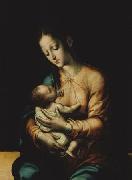 |
Luis de Morales -- Click Here
|
|
(1510 - 9 May 1586) was a Spanish painter born in Badajoz, Extremadura. Known as "El Divino", most of his work was of religious subjects, including many representations of the Madonna and Child and the Passion.
Influenced, especially in his early work, by Raphael Sanzio and the Lombard school of Leonardo, he was called by his contemporaries "The Divine Morales", because of his skill and the shocking realism of his paintings, and because of the spirituality transmitted by all his work.
His work has been divided by critics into two periods, an early stage under the influence of Florentine artists such as Michelangelo and a more intense, more anatomically correct later period similar to German and Flemish renaissance painters
|
|
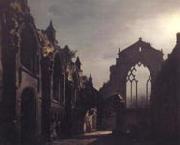 |
Luis Daguerre -- Click Here
|
|
French Painter , (1789-1851) |
|
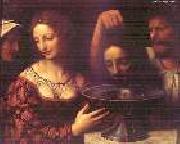 |
LUINI, Bernardino -- Click Here
|
|
Italian High Renaissance Painter, ca.1480-1532
Italian painter and draughtsman. He was one of the generation of Lombard painters active around 1500 who, influenced by Leonardo and Raphael, blended High Renaissance innovations with indigenous Milanese elements to create a Lombard Renaissance style. Luini's paintings were extremely popular with both collectors and critics from c. 1790 to the end of the 19th century. This widespread popularity, however, had unfortunate consequences: many of his frescoes were detached from their original settings, many of the panel paintings were transferred to canvas and other works were heavily restored. As a result few survive in a good state. About 700 works are attributed to Luini, but many of these attributions are over optimistic.
|
|
|
|
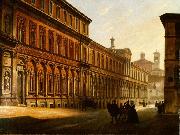 |
Luigi Premazzi -- Click Here
|
|
(Milan, 1814 - Istanbul, Turkey, 1891) was an Italian painter.
Premazzi attended the Brera Academy of Fine Arts and then the private school run by Giovanni Migliara. His early watercolours, based on the works of his master, were produced for the lithographic industry. His oeuvre is characterised by a repertoire of urban views produced in accordance with the dictates of perspective painting. While most of these are set in Milan, other Italian cities were also featured in later years. His smooth, precise painting also shows the influence of his contemporary Luigi Bisi in its descriptive focus on architectural detail. He presented work regularly at the exhibitions of the Societe Promotrice di Belle Arti in Turin from 1842 to 1848 as well as those of the Brera Academy. Having moved to Saint Petersburg around 1850, he became a teacher at the Imperial School of Fine Arts there in 1861. Frequent stays in the Caucasus and the Middle East provided new subjects for his paintings, which he continued to send to Italian exhibitions, where they aroused wonder and curiosity.
|
|
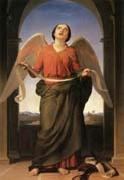 |
Luigi Mussini -- Click Here
|
|
Italian , Berlino, 1813 - Siena, 1888 |
|
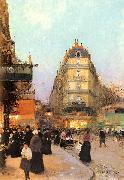 |
Luigi Loir -- Click Here
|
|
French painter and engraver Luigi Loir (1845-1916). |
|
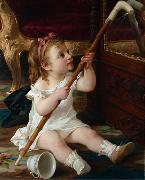 |
Luigi Crosio -- Click Here
|
|
(1835-1915) was an Italian painter who lived and worked in Turin, Italy. He died in Turin and is recorded as having been born in Alba, but the town of Aqua a few miles north of Alba claims Crosio was born there.
He attended the Accademia Albertina di Belle Arte in Turin. His immediate work afterwards tilted towards commercial paintings, but thereafter he specialised in genre painting with romantic 18th century scenes and portraits or period characters or Pompeian scenes. He also liked the opera and depicted several scenes from popular operas. He was also listed as a lithographer and was involved in publishing books and images.
He had several daughters and one of them, Carola Crosio, married the famous mathematician Giuseppe Peano (of Peano axioms fame) in 1887.
In 1898 he painted the famous Refugium Peccatorum Madonna (i.e. Refuge of Sinners Madonna) which was later also called Mother Thrice Admirable Madonna. |
|
|
|
|
| | |
|
|
|
|